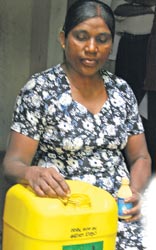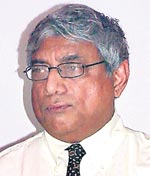
Out of the debris arose healthy villagesWhat started off as a post-tsunami project to prevent communicable diseases in Thotagamuwa, has now turned into a many-pronged success story. The house is half-built and whatever can be called furniture is a few chairs scattered around the living room. From the kitchen wafts the delicious smell of a spicy chicken curry while the pride of place is occupied by a large jerry-can full of water.“My husband has gone to Akka’s home quite far away to have a bath,” explains K. Sujeewa Kumari, who lives in the Thotagamuwa area near Hikkaduwa, Galle. Yes, there is a well but the water is yellow and cannot be touched, says this mother of three young children aged 12, 11 and 10. They are compelled to carry the water from a well and use that for drinking and cooking.
Boiling and cooling the drinking water are difficult options for them for they are in dire financial straits. The husband who is disabled, after being knocked down by a vehicle hobbles around on crutches, while Kumari rears poultry and sells the eggs and chickens to feed her family. The house was built by her after toiling in the Middle East but now the money is gone and she is planning to leave her children with her mother and go abroad once again. Water has been the cause of many sleepless nights, visits to hospital and absence from school for the children because of paachanaya (diarrhoeal diseases). Although the tsunami left in its wake unimaginable tragedy and despair, it has also brought about winds of change to the lives of harried and humble wives and mothers in the area. No boiling of water is required using firewood or kerosene……..but water-borne disease prevention is only a matter of adding a capful of liquid from a small bottle, says 53-year-old M.G. Dayawathie, offering glasses of water not only to The Sunday Times team in her home in the same area but also to her toddler grandson. Adds Kumari, chlovathurata wisha beeja maranawa, explaining that the germs die for chlovathura. It was after the tsunami that a tiny but very successful project took root in the area firstly to prevent communicable diseases such as diarrhoea and also mosquito-borne diseases such as dengue and has now spread, three years later to providing self-employment, counselling for addictions of different kinds and even rabies control. How did the Thotagamuwa Area Tsunami Relief Health Project come about? The seed germinated when Dr. Panduka Wijeyaratne, a retired preventive health doctor who had worked abroad for many long years left his home in Colombo accompanied by his son and his brother to check on two aged cousins who were living in the Maha Gedera (his father’s ancestral home) in Thotagamuwa the day the tsunami struck. Reaching Thotagamuwa 11 hours later, using by-roads as Galle Road was impassable from Katukurunda onwards, they were led to the Aluthwela temple where hundreds of displaced people were camped. A maid who had worked at the Maha Gedera was located and with a few villagers they made their way through rocks, stones, debris and uprooted trees to the Maha Gedera, only to find that one cousin who had gone to the pola had unfortunately been killed. They found the body and as soon as the water receded, buried her. It was back to Colombo after that. Having worked the last six years before retirement on an infectious disease prevention programme of USAID in Nepal and also been in and out of Washington DC in America, Dr. Wijeyaratne got thinking.What could he do? “I did what I could do best,” he says simply. “I wanted to get involved in preventive health in keeping with my experience. And where else to start but in my hometown.”
February 2005 saw him and a few others returning to the Maha Gedera and setting up base camp for what he had identified as a small project to help the people, after much discussion with the Medical Officer of Health and also the Lions Club of Hikkaduwa, the Epidemiology Unit in Colombo and the Dept. of Community Medicine, Kelaniya University. The project started small, with the intention of preventing the vector-borne diseases of filaria, dengue, chikungunya and Japanese Encephalitis by raising awareness not only on how to destroy mosquito-breeding spots but also through the provision of more than 16,000 insecticide-treated nets, two nets for small families and three for large ones. Mobilizing a group of young volunteers from the area itself, Dr. Wijeyaratne was not satisfied with just handing out mosquito nets to families. The nets had been bought by friends and colleagues abroad who chipped in to assist him. “We designed a special label with clear instructions on how to put up the net and use it,” he says. Street dramas on dengue and awareness programmes for children were part of the strategy. Simultaneously, the project looked at water-borne diseases in the target areas of Hikkaduwa, Thotagamuwa, Malawenna, Kalupe, Seenigama, Peraliya, Telwatte and Akurala. “Did you know that 80% of the people in this area rely on wells for their water while only 20% have access to pipe-borne water? Did you also know that most people do wash their hands after using the toilet but seldom use soap?” he asks. The simple lessons began for knots of people gathered firstly at the Maha Gedera and as the project expanded at its own office down Aluthwela Road. Explains community assistant Niluka Damayanthi, “We took two bowls of water and just dipped our hands in one, rubbing them together. Next we lathered our hands with soap and washed off the soap in the second bowl. Then we got the people to compare the water in both.” Hand-washing was a massive campaign, with mothers espcially going back with an important message for their children, says Dr. Wijeyaratne. The project’s focus also moved to the water itself. Was it safe for drinking? Promoting healthy living to make sure that diarrhoeal diseases could be kept at bay, the project introduced chlovathura. Contacting the US Centers for Disease Control on how to introduce a safe water system, the project hit on the idea of producing chlorine locally. Care, a private company, extended a helping hand producing clovathura and giving it at cost to the project. A 20-litre jerry can each was distributed to 8,000 families in the seven Grama Sevaka divisions of Thotagamuwa, Werellana, Seenigama, Wellawatte, Kalupe, Malawena and Telwatte-Peraliya. Only one capful is needed for one jerry-can, he says. Looking into the total wellbeing of the people became necessary and the project branched out into such diverse areas as sterilization and vaccination of stray dogs, 834 in all with the help of the Blue Paw Trust and the Tsunami Animal & People Alliance and awareness on sexually transmitted diseases to providing self-employment to a few tsunami-affected women and holding religious programmes. “I had several sewing machines before the tsunami destroyed our livelihood,” says K.D. Niloufer Sharmalee, 30, cradling her nine-month-old son. “The whole village knew I sewed bridal clothes and other stuff, even employing girls to work the machines. The machines went with the waves. This project has given me a machine and I have another, so I can get back on my feet.” The small eating house run by E. Indrani was destroyed by the tsunami and she now operates her business from a plank shop, built up through sheer grit in the face of adversity. The project has assisted her to put up a permanent building. “I will open my avanhala in two weeks’ time,” she beams proudly. As the project winds down this month, sustainability has been ensured by the empowerment through knowledge of the people themselves……...mothers who know the value of buying a cake of soap as against the cost of hospital visits and workdays lost and households which need to spend only Rs. 1.15 on a bottle of chlovathura as against boiling water at a cost of over Rs. 40 using firewood.
|
|| Front
Page | News | Editorial | Columns | Sports | Plus | Financial
Times | International | Mirror | TV
Times | Funday
Times || |
| |
Copyright
2007 Wijeya
Newspapers Ltd.Colombo. Sri Lanka. |

